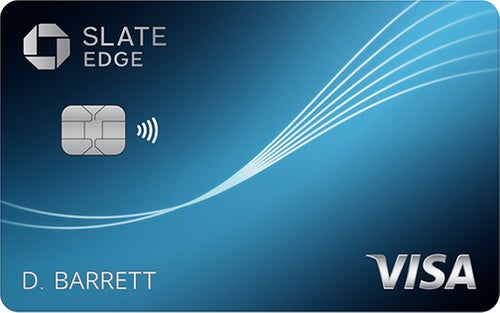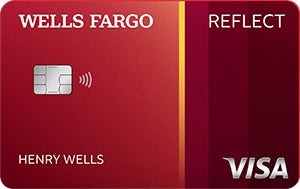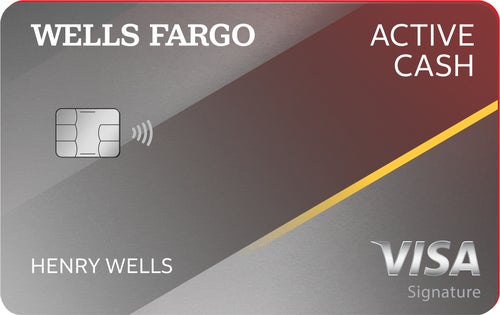- Intro Offer
-
No current offer
- Annual fee
- $0
- APR
- 20.49% – 29.24% Variable
- Recommended Credit A credit score is used to indicate an applicant’s credit worthiness and may provide guidance about account eligibility. It does not necessarily guarantee approval for any financial product.
-
670 – 850
Good – Excellent
- Rewards rate
-
N/A This card doesn’t offer cash back, miles, or points
The Chase Slate Edge℠* provides cardholders with an opportunity to avoid interest charges on purchases and balance transfers with its long introductory APR offer. Distinctively, after the intro APR offer is finished, you’re able to lower the card’s APR by up to 2% annually by paying on time and spending at least $1,000 on your card by your next account anniversary.
Just be aware that there are no rewards, so if you choose to use the Slate Edge to finance a large purchase, you’d miss out on any return on your spending. But that’s common among credit cards with long introductory balance transfer offers.
The Slate Edge’s primary use is to help you get rid existing credit card debt that’s accruing interest on another card. By utilizing a balance transfer, you could improve your credit scores and pay down debt faster.
Introductory APR on balance transfers and purchases
The Slate Edge offers 18 months of 0% introductory APR on balance transfers and purchases alike (20.49% to 29.24% variable APR thereafter). That’s a competitive offer for both.
For balance transfers, you need to pay attention to the timeframe. The time starts ticking as soon as you open your account, unlike other cards that offer a buffer window of 30-120 days. So, if you initiate a balance transfer after having the card for three months, you’ll only be able to use the remaining 15 months of 0% introductory APR on that balance.
You’ll also want to initiate your balance transfer within the first 60 days of account ownership. There is an intro balance transfer fee of 3% with a $5 minimum -- the industry standard -- that jumps up to 5% ($5 minimum) after that initial 60 days.
The intro APR on purchases is more straightforward. You have 18 months from the date of account opening to enjoy 0% introductory APR on your purchases (then 20.49% to 29.24% variable APR), as long as you make your minimum payments on time.
We recommend paying the balance off -- whether from balance transfer or purchases -- by the 18-month mark, so you avoid the regular variable APR of 20.49% to 29.24%. But if you can’t avoid doing so, this card has a special feature that could help save you some money.
Lowering your regular APR
Most credit cards assign your regular APR based on your creditworthiness and the prime rate, or, base interest rate assigned for top credit scores based on the federal funds rate. However, the Chase Slate Edge makes it possible to lower your APR with good behavior.
You can qualify for up to a 2% reduction in APR per year if you pay on time and spend at least $1,000 on your card by your account anniversary date. You can earn this benefit until your APR reaches the prime rate plus 9.74%.
Other features
The Chase Slate Edge offers more extras than most other introductory APR and balance transfer cards. You’ll get purchase protection, extended warranty protection and auto rental collision damage waiver.
With purchase protection, you can get reimbursed for damaged or stolen purchases. You may get up to $500 per claim, for a total of $50,000 per account -- but any claims must be made within 120 days of purchase.
Extended warranty protection similarly safeguards you from purchases gone awry. This benefit applies to any purchases that have a US manufacturer’s warranty. In those cases, the Chase Slate Edge extends your warranty time period by a year on eligible warranties of three years or less.
If you book car rentals with your Chase Slate Edge, you can opt out of paying for collision insurance offered by the car rental company. The Slate Edge gives you the same protection for most car rentals in the US and abroad in the event of collision damage or theft. It’s important to note, however, that this coverage is secondary to your main driver’s insurance and won’t pay out until after your primary insurance has done so.
Alternative cards
Wells Fargo Reflect® Card
The Wells Fargo Reflect® Card offers a longer intro APR on qualifying balance transfers and purchases. This card offers a 0% introductory APR for 21 months from account opening on purchases and qualifying balance transfers (18.24%, 24.74%, or 29.99% variable APR thereafter).
Keep in mind that this offer also starts the day your account is opened, so you’ll want to make planned large purchases or qualifying balance transfers right away to get the most value out of this offer. And make sure you initiate a balance transfer within 120 days to take advantage of the intro rate. There is a balance transfer fee of 5%, with a $5 minimum.
To learn more about what the Wells Fargo Reflect Card offers, check out our full review.
BankAmericard® credit card
The BankAmericard® credit card* is a good credit card to choose if you need to take advantage of a balance transfer. Cardholders get 18 billing cycles to pay down a transferred balance or a new purchase at an introductory 0% APR (then 16.24% to 26.24% variable).
And while it does offer a solid amount of time to pay off new purchases, like the Chase Slate Edge, there are no rewards. It’s also important to note that cardholders will need to complete any balance transfers within 60 days of account opening, and there is an introductory balance transfer fee of 3% of the amount of each transaction for 60 days from account opening (then 4%).
For more information, check out our BankAmericard credit card review.
FAQs
Though balance transfer credit cards are technically credit cards, they’re more like a debt-financing tool. They’re better used to pay off existing credit card debt than as a payment method.
A balance transfer is when you take the debt, or balance, you owe on one card account and transfer it to another credit card account. Usually this is done with the goal of saving money by transferring debt from a high-interest account to one with lower or no interest.
While many credit cards allow balance transfers, those primarily designed for the purpose all share one main feature: an introductory 0% APR period on balances transferred to that account, typically applicable to transfers made within the first 60 to 120 days of card ownership. The introductory APR period generally lasts between 12 and 21 months, giving you a significant period of time to pay off your balance interest-free.
While a few credit cards offer no-fee transfers, most balance transfer cards charge a fee to transfer your debt, usually between 3% and 5%. Broadly speaking, the longer the introductory 0% APR period, the higher the fee, and vice versa. So the best cards without a balance transfer fee have a shorter introductory APR period, and those with the longest introductory APR period have a 3% to 5% transfer fee.
Technically, yes. In some cases, transferring your balance two or three times might even be what’s necessary to finally pay off your debt. But unless you have a firm understanding of how you got into debt in the first place and a plan for getting out of debt, you won’t be working toward a solution.
While transferring your remaining debt to a second balance transfer card may allow you to pay off your balance without monthly interest or a fee, it’s important to note that there are too many variables for multiple balance transfers to be a failure-proof debt strategy.
For example, your card application could be denied, your credit limit could be much lower than you anticipated or your transfer request could be denied. Credit card offers could also change, making it difficult to plan ahead. For this reason I recommend selecting a card that allows you to pay off the full balance after one cycle if possible.
It could take anywhere between 10 days and six weeks to complete a balance transfer after you receive your new card and cardholder agreement. It’s also important to note that some card issuers, such as Citi, make balance transfers available at their discretion, and could therefore decline a transfer request. You should probably still pay the minimum on the old card’s balance until you’ve confirmed that the transfer was completed, so you don’t run the risk of fees or penalties.
Our approach
We review the cards that are in the highest demand and offer the best benefits. We scour the fine print so there aren’t any surprises when you open an account. We find the key factors that make a card stand out and compare them to other top cards. That way, readers can opt for a different card with similar features if our pick isn’t right for them. Our reviews are regularly checked and updated to incorporate new recommendations, as well as to reflect changes in offers and the market.
*All information about the Chase Slate Edge and the BankAmericard credit card has been collected independently by CNET and has not been reviewed by the issuer.
The editorial content on this page is based solely on objective, independent assessments by our writers and is not influenced by advertising or partnerships. It has not been provided or commissioned by any third party. However, we may receive compensation when you click on links to products or services offered by our partners.



